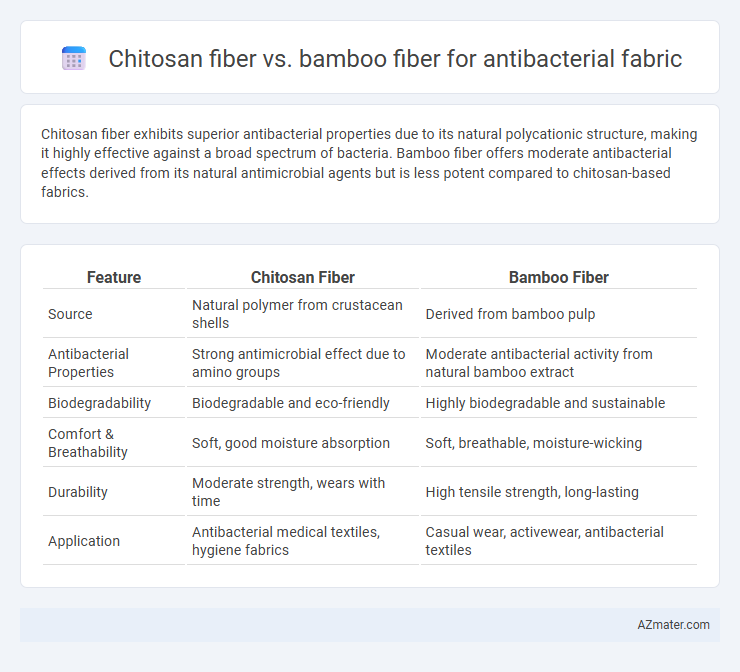Chitosan fiber exhibits superior antibacterial properties due to its natural polycationic structure, making it highly effective against a broad spectrum of bacteria. Bamboo fiber offers moderate antibacterial effects derived from its natural antimicrobial agents but is less potent compared to chitosan-based fabrics.
Table of Comparison
| Feature | Chitosan Fiber | Bamboo Fiber |
|---|---|---|
| Source | Natural polymer from crustacean shells | Derived from bamboo pulp |
| Antibacterial Properties | Strong antimicrobial effect due to amino groups | Moderate antibacterial activity from natural bamboo extract |
| Biodegradability | Biodegradable and eco-friendly | Highly biodegradable and sustainable |
| Comfort & Breathability | Soft, good moisture absorption | Soft, breathable, moisture-wicking |
| Durability | Moderate strength, wears with time | High tensile strength, long-lasting |
| Application | Antibacterial medical textiles, hygiene fabrics | Casual wear, activewear, antibacterial textiles |
Introduction to Antibacterial Fabrics
Antibacterial fabrics like chitosan fiber and bamboo fiber inhibit microbial growth through natural properties derived from their sources. Chitosan fiber, extracted from shrimp shells, exhibits strong antimicrobial activity due to its positively charged molecules disrupting bacterial cell walls. Bamboo fiber contains natural bioactive agents such as bamboo kun, providing moderate antibacterial effects and moisture-wicking benefits ideal for hygienic clothing.
Overview of Chitosan Fiber
Chitosan fiber, derived from chitin found in crustacean shells, exhibits strong antibacterial properties due to its natural polycationic structure that disrupts microbial cell membranes. This biocompatible and biodegradable fiber is widely used in antibacterial fabric applications for healthcare and hygiene products, offering superior antimicrobial efficacy compared to bamboo fiber. Its ability to inhibit a broad spectrum of bacteria, including Staphylococcus aureus and Escherichia coli, makes chitosan fiber a preferred choice for functional textiles requiring enhanced hygiene and odor control.
Overview of Bamboo Fiber
Bamboo fiber exhibits inherent antibacterial properties due to the presence of natural bioagents such as bamboo kun, which inhibit bacterial growth and reduce odor. Its eco-friendly production process involves chemical or mechanical extraction from bamboo pulp, resulting in a soft, breathable fabric ideal for antimicrobial applications. Compared to chitosan fiber, bamboo fiber offers superior moisture-wicking capabilities, enhancing comfort in antibacterial textiles used in healthcare and activewear sectors.
Antibacterial Mechanisms of Chitosan Fiber
Chitosan fiber exhibits superior antibacterial properties due to its unique mechanism involving the polycationic nature of chitosan, which binds to negatively charged bacterial cell membranes, causing leakage of cellular contents and inhibition of microbial growth. This fiber disrupts bacterial metabolism and induces structural changes in the cell wall, leading to effective antibacterial activity against a broad spectrum of pathogens. In contrast, bamboo fiber primarily relies on natural antimicrobial compounds but does not match the potent membrane-disrupting action of chitosan, making chitosan fiber a more effective choice for antibacterial fabric applications.
Antibacterial Mechanisms of Bamboo Fiber
Bamboo fiber exhibits antibacterial properties primarily due to the presence of natural antimicrobial agents such as bamboo kun, a bio-agent found in bamboo pulp that inhibits the growth of bacteria and fungi. This mechanism disrupts bacterial cell walls, leading to cell death and preventing odor-causing microbial proliferation. In contrast, chitosan fiber's antibacterial effect arises from its polycationic nature, which interacts with negatively charged bacterial membranes, but bamboo fiber offers a more natural and environmentally friendly solution with inherent antibacterial compounds.
Comparison of Antibacterial Efficacy
Chitosan fiber exhibits superior antibacterial efficacy due to its natural polycationic structure, which disrupts bacterial cell membranes and inhibits microbial growth effectively against a broad spectrum of bacteria including E. coli and S. aureus. Bamboo fiber, while possessing inherent antibacterial properties attributed to a substance called "bamboo kun," generally demonstrates a milder antimicrobial effect compared to chitosan and relies more on physical fiber structure than active biochemical interactions. Studies show chitosan-treated fabrics achieve higher inhibition zones and longer-lasting antibacterial performance, making them more suitable for medical textiles requiring stringent microbial control.
Durability and Wash Resistance of Fibers
Chitosan fiber exhibits superior antibacterial durability and wash resistance compared to bamboo fiber due to its inherent bioactive properties and strong fiber matrix binding. Bamboo fiber's antibacterial efficacy tends to diminish rapidly after repeated washing because its antibacterial agents are less permanently integrated into the fabric structure. For long-term antibacterial performance in textile applications, chitosan fiber offers enhanced durability and sustained antimicrobial functionality across multiple wash cycles.
Environmental Impact and Sustainability
Chitosan fiber, derived from crustacean shells, offers excellent antibacterial properties while promoting sustainability through waste valorization and biodegradability, reducing environmental pollution. Bamboo fiber, produced from bamboo plants, is renewable and requires less water and pesticides, making it a low-impact option; however, the chemical processing involved can raise ecological concerns. Both fibers contribute to sustainable antibacterial fabrics but vary in environmental footprint depending on raw material source and manufacturing processes.
Applications in Textile Industry
Chitosan fiber exhibits superior antibacterial properties due to its natural ability to inhibit bacterial growth, making it ideal for medical textiles, sportswear, and hygiene products where microbial resistance is critical. Bamboo fiber, while also possessing antibacterial qualities derived from bamboo kun, is more commonly used in everyday apparel and home textiles because of its softness and moisture-wicking properties. The textile industry increasingly favors chitosan fiber for specialized applications like wound dressings and antimicrobial uniforms, whereas bamboo fiber serves a broader market emphasizing comfort and sustainability.
Future Prospects and Innovations
Chitosan fiber demonstrates promising advancements in antibacterial fabric technology due to its natural biocompatibility, biodegradability, and inherent antimicrobial properties derived from chitin in shellfish. Bamboo fiber, enriched with antibacterial agents like bamboo kun, benefits from sustainable cultivation and innovative enzymatic treatments enhancing its antimicrobial efficacy and moisture management. Future prospects emphasize hybridizing chitosan and bamboo fibers with nanotechnology and smart textiles to create next-generation antibacterial fabrics with improved durability, environmental sustainability, and multifunctional performance.

Infographic: Chitosan fiber vs Bamboo fiber for Antibacterial fabric
 azmater.com
azmater.com